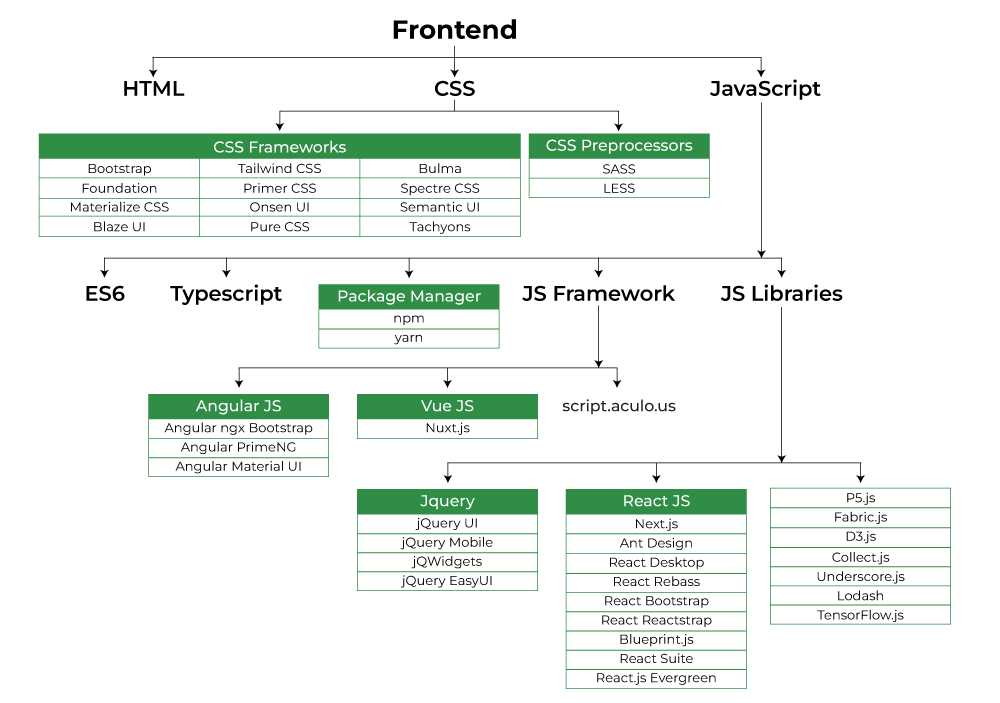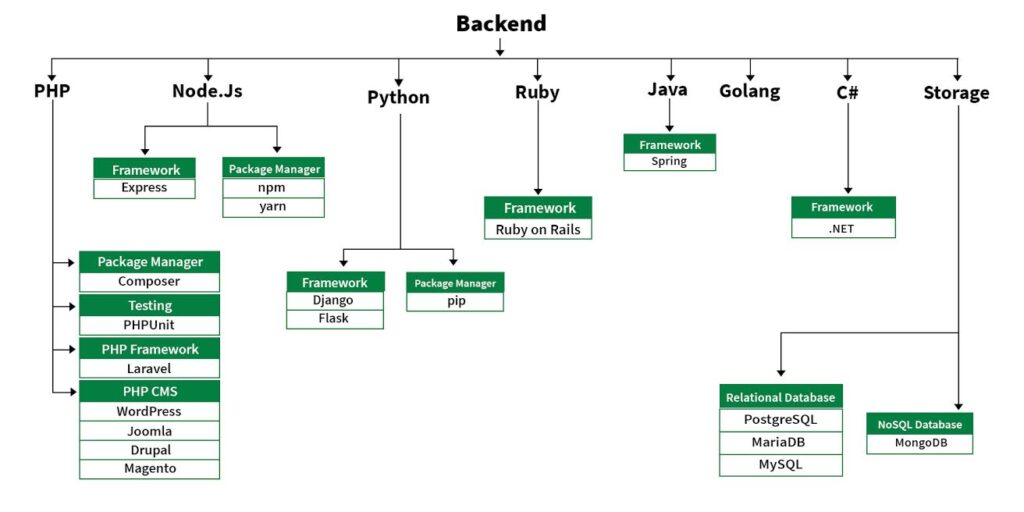
Web Development
Web development refers to the creating, building, and maintaining of websites. It includes aspects such as web design, web publishing, web programming, and database management. It is the creation of an application that works over the internet i.e. websites.
Websites can vary widely in their purpose, functionality, and content. Here are some common types of websites:
1. **E-commerce Websites:** E-commerce websites are online platforms where businesses sell products or services. Customers can browse products, add them to cart, and make purchases securely through the website. Examples include Amazon, eBay, and Etsy.
2. **Blog or Personal Websites:** Blog or personal websites are platforms where individuals or bloggers share their thoughts, experiences, expertise, and interests with an online audience. They may cover a wide range of topics, including travel, food, fashion, technology, and more. Examples include WordPress.com, Blogger, and Medium.
3. **Corporate or Business Websites:** Corporate or business websites represent companies, organizations, or institutions online. They provide information about the company’s products, services, history, mission, team, and contact details. These websites often serve as a primary marketing and branding tool. Examples include Apple, Microsoft, and Coca-Cola.
4. **Portfolio Websites:** Portfolio websites showcase the work, projects, and achievements of individuals or professionals in fields such as design, photography, art, writing, and filmmaking. They serve as a digital portfolio to showcase skills and attract potential clients or employers. Examples include Behance, Dribbble, and Adobe Portfolio.
5. **Educational Websites:** Educational websites provide resources, materials, courses, and information related to education and learning. They may include online courses, tutorials, lectures, quizzes, and educational content for students, teachers, and lifelong learners. Examples include Khan Academy, Coursera, and edX.
6. **News and Media Websites:** News and media websites provide up-to-date news, articles, videos, and multimedia content on various topics, including politics, sports, entertainment, finance, and world events. They often include sections for breaking news, feature stories, opinion pieces, and user engagement. Examples include BBC News, CNN, and The New York Times.
7. **Social Networking Websites:** Social networking websites connect users with friends, family, colleagues, and communities online. They allow users to create profiles, share updates, photos, videos, and interact with others through comments, likes, and messages. Examples include Facebook, Twitter, and LinkedIn.
8. **Community or Forum Websites:** Community or forum websites provide a platform for users to discuss topics of interest, ask questions, seek advice, and share opinions with like-minded individuals. They often include categories, threads, and user-generated content. Examples include Reddit, Quora, and Stack Overflow.
9. **Wiki Websites:** Wiki websites are collaborative platforms where users can create, edit, and contribute content collectively. They typically focus on creating a knowledge base or encyclopedia on specific topics, allowing users to access and modify information freely. Examples include Wikipedia, Wikibooks, and WikiHow.
10. **Government or Nonprofit Websites:** Government or nonprofit websites represent government agencies, public services, or charitable organizations online. They provide information about government programs, services, regulations, and resources, as well as opportunities for civic engagement and support. Examples include USA.gov, United Nations, and World Health Organization (WHO).
These are just a few examples of the types of websites that exist. Websites can also be hybrids, combining elements of different types to serve specific purposes or cater to diverse audiences.
Websites are essential for individuals, businesses, organizations, and institutions for various reasons
1. **Online Presence:** A website acts as your digital storefront, providing a space where people can learn more about you or your business at any time, from anywhere in the world. It serves as a central hub for information about your products, services, or personal brand.
2. **Credibility and Trustworthiness:** In today’s digital age, having a professional-looking website lends credibility to your business or personal brand. It instills trust in potential customers or visitors who are researching your products, services, or expertise.
3. **Marketing and Branding:** Websites are powerful marketing tools, allowing you to showcase your brand identity, values, and unique selling points. Through engaging content, visuals, and user experience, you can attract and retain visitors, convert them into customers, and foster brand loyalty.
4. **E-commerce platforms:** Unlike physical stores or offices, websites are accessible 24/7, enabling potential customers to learn about your offerings and make purchases or inquiries at their convenience. This accessibility expands your reach beyond geographical boundaries and time zones.
**Sales and E-commerce:** For businesses, e-commerce websites enable online sales, allowing customers to browse products, make purchases, and track orders seamlessly. This opens up new revenue streams and expands market opportunities beyond physical locations.
5. **Information Dissemination:** Websites serve as repositories of information, offering resources, articles, FAQs, and documentation to educate and inform visitors. They can also host blogs, news sections, or knowledge bases to share insights, expertise, and industry trends.
6. **Recruitment and Talent Acquisition:** Organizations utilize websites to attract potential employees by showcasing job opportunities, company culture, benefits, and career growth prospects. This helps in recruiting top talent and building a strong team.
7. **Community Building and Networking:** Websites can foster online communities, forums, or membership portals where like-minded individuals can connect, share experiences, and collaborate on common interests or goals.
8. **Analytics and Insights:** Websites provide valuable data through analytics tools, offering insights into visitor behavior, demographics, traffic sources, and conversion rates. This data helps in optimizing marketing strategies, improving user experience, and making informed business decisions.
Overall, websites play a crucial role in establishing your online presence, building credibility, reaching a global audience, facilitating communication, driving sales, and achieving your personal or business objectives in the digital realm.
There are several popular websites and platforms that businesses use for marketing and branding purposes. Here are some of the most prominent ones
1. **Facebook:** With billions of active users worldwide, Facebook remains one of the most popular social media platforms for marketing and branding. Businesses can create Pages, run targeted ads, share content, engage with followers, and leverage various features to promote their products or services.
2. **Instagram:** Known for its visual-centric nature, Instagram is widely used by businesses to showcase their products or services through images and videos. With features like Stories, Reels, and IGTV, businesses can engage with their audience in creative ways and build a strong brand presence.
3. **Twitter:** Twitter is a microblogging platform where businesses can share updates, news, promotions, and engage in conversations with their audience in real-time. It’s an effective platform for building brand awareness, fostering customer relationships, and staying updated on industry trends.
4. **LinkedIn:** LinkedIn is a professional networking platform used by businesses to connect with professionals, showcase expertise, and build thought leadership in their industry. Businesses can share content, participate in groups, and run targeted advertising campaigns to reach their target audience.
5. **YouTube:** As the largest video-sharing platform, YouTube offers businesses an opportunity to create and share video content to promote their products, services, and brand. Businesses can create tutorials, product demos, vlogs, and advertisements to engage with their audience and drive traffic to their website.
6. **Google My Business:** Google My Business is a free tool that allows businesses to manage their online presence across Google, including Google Search and Maps. Businesses can create a profile, add photos, respond to reviews, and provide essential information to help customers find and connect with them.
7. **Pinterest:** Pinterest is a visual discovery platform where users can find inspiration, ideas, and products through images and pins. Businesses can create visually appealing boards, share product images, and drive traffic to their website through Pins and promoted Pins.
The websites of some popular institutions:
Certainly! Here are links to the websites of some popular institutions:
1. **Harvard University:** [Harvard University Website](https://www.harvard.edu/)
2. **Stanford University:** [Stanford University Website](https://www.stanford.edu/)
3. **Massachusetts Institute of Technology (MIT):** [MIT Website](https://www.mit.edu/)
4. **Yale University:** [Yale University Website](https://www.yale.edu/)
5. **University of Oxford:** [University of Oxford Website](https://www.ox.ac.uk/)
6. **University of Cambridge:** [University of Cambridge Website](https://www.cam.ac.uk/)
7. **Princeton University:** [Princeton University Website](https://www.princeton.edu/)
8. **California Institute of Technology (Caltech):** [Caltech Website](https://www.caltech.edu/)
9. **Columbia University:** [Columbia University Website](https://www.columbia.edu/)
10. **University of California, Berkeley:** [UC Berkeley Website](https://www.berkeley.edu/)
Please note that the URLs provided are for the official websites of these institutions. You can visit these links to learn more about the institutions, their programs, faculty, research, and other offerings.
https://brainstation.io/career-guides/what-is-web-development
The word Web Development is made up of two words, that is:
- Web: It refers to websites, web pages or anything that works over the internet.
- Development: It refers to building the application from scratch.
Web Development can be classified into two ways:

Popular Frontend Technologies
- HTML: HTML stands for HyperText Markup Language. It is used to design the front end portion of web pages using markup language. It acts as a skeleton for a website since it is used to make the structure of a website.
- CSS: Cascading Style Sheets fondly referred to as CSS is a simply designed language intended to simplify the process of making web pages presentable. It is used to style our website.
- JavaScript: JavaScript is a scripting language used to provide a dynamic behavior to our website.
- Bootstrap: Bootstrap is a free and open-source tool collection for creating responsive websites and web applications. It is the most popular CSS framework for developing responsive, mobile-first websites. Nowadays, the websites are perfect for all browsers (IE, Firefox, and Chrome) and for all sizes of screens (Desktop, Tablets, Phablets, and Phones).
